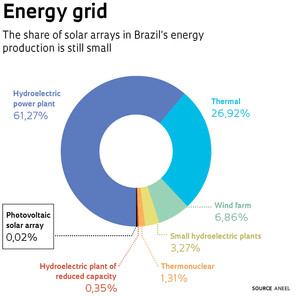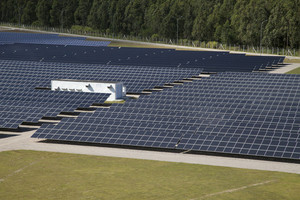 Solar energy production using photovoltaic technology in Brazil is growing at a fast pace, even though it still accounts for less than 0.02% of the country’s energy grid. According to data from the Brazilian National Electricity Agency (ANEEL), during the first quarter of this year the installed potential in the country reached 107.6 megawatts (MW), 15 times more than the same period in 2015. To guide expansion of the use of this kind of energy in the country, the Brazilian National Institute for Space Research (INPE) has launched the second edition of the Brazilian Atlas of Solar Energy, which brings together a set of data accumulated over the past 17 years on the incidence of solar radiation and the places which are most suitable for installation of photovoltaic modules. The document replaces the first version of the Atlas, which was published in 2006 and gathered a smaller range of data related to the previous decade.
Solar energy production using photovoltaic technology in Brazil is growing at a fast pace, even though it still accounts for less than 0.02% of the country’s energy grid. According to data from the Brazilian National Electricity Agency (ANEEL), during the first quarter of this year the installed potential in the country reached 107.6 megawatts (MW), 15 times more than the same period in 2015. To guide expansion of the use of this kind of energy in the country, the Brazilian National Institute for Space Research (INPE) has launched the second edition of the Brazilian Atlas of Solar Energy, which brings together a set of data accumulated over the past 17 years on the incidence of solar radiation and the places which are most suitable for installation of photovoltaic modules. The document replaces the first version of the Atlas, which was published in 2006 and gathered a smaller range of data related to the previous decade.
The Atlas, which was produced in collaboration with institutions such as the Federal Universities of São Paulo and Santa Catarina, the Federal University of Technology–Paraná, and the Federal Institute of Santa Catarina, has identified that Brazil has the potential to generate 2,281 kilowatt-hours of solar energy per square meter per year (kWh/m²/year), enough to supply annual residential demand in the states of Bahia and Pernambuco three times over. The study confirms that the highest values for solar radiation occur in the area known as the Solar Belt, a swath of land extending from the Northeast region of Brazil to the Pantanal wetlands (see Map), particularly the dry Sertão area of Bahia and a large part of Minas Gerais. A new development is the recommendation that investments in new photovoltaic generation plants also look farther south to areas in southwestern Minas Gerais, through northwestern São Paulo, and northern Paraná. Although these areas have slightly lower levels of solar radiation than the Northeast, they have access to more points for connecting to the country’s power transmission system.
“The states in the Northeast have more frequent sun, but are in a region with fewer options to connect with the national electricity distribution network. This could make projects in the region unfeasible, since it makes connecting the photovoltaic plants to the distribution networks more expensive,” explains physicist Enio Pereira, a researcher at the Laboratory of Modeling and Studies of Renewable Energy Resources at INPE and the coordinator of the study. The goal is to avoid problems like the ones which appeared in the production of wind power in the country. “Some wind farms were installed in the Northeast without sufficient transmission lines. This situation ended up necessitating new investments in energy transport.” The cost of deploying solar energy is still high; it currently costs approximately R$8 million to build a solar generation plant with 1 MW installed capacity. This represents an average of three times the cost of constructing a wind generation plant with the same capacity. Brazil has some solar arrays, such as the Tauá solar plant in Ceará and the Cidade Azul plant in Tubarão, Santa Catarina.
 Updated monitoring
Updated monitoring
As was the case with the 2006 Atlas, the new edition is meant to guide the development of policies for the solar energy sector. “The first Atlas was launched at a time when photovoltaic solar energy was taking its first steps, and helped the Brazilian Power Research Company [EPE, a public company linked to the Ministry of Mines and Energy] implement the first projects,” says Pereira. The new study presents a larger set of data and analyses. “We refined the data and improved the methodologies. The Atlas works as a tool to encourage investors to establish more solar power projects, now with a more reliable evidence base,” he states. The information was collected from more than 500 solar measuring stations scattered through the country, and from satellite monitoring of the solar radiation rates over the last 17 years.
The study shows that Brazil has fairly uniform distribution of solar radiation, which varies little over the geography of the country. An exception is the Amazon region, which has significant rainfall during the year and therefore is not attractive for large solar energy enterprises. “The cloudiness in the Amazon has a negative impact on power generation in solar plants,” says Pereira.
But he adds that this does not stop solar microgeneration projects based on rooftop solar panels from being implemented in the region. Physicist Izete Zanesco, a researcher at the Solar Energy Technology Center at the Pontifical Catholic University of Rio Grande do Sul (PUC-RS), stresses that planning in this sector should consider areas outside the Solar Belt. “Since Brazil has favorable levels of solar radiation throughout its entire territory, photovoltaic modules can be installed in homes or businesses anywhere in the country,” she says. As for large photovoltaic installations, Zanesco acknowledges that it is more productive to follow the information in the Atlas and install these in the regions with the highest solar radiation rates.
 ANEEL estimates that by 2024, more than 800,000 households in Brazil will produce their own electricity from the sun. By the first quarter of 2015, 556 microgeneration systems had been installed in the country; these devices have installed capacity of up to 75 kW. By August 2017, this number had soared to 12,977. Most of these systems are concentrated in the states of Minas Gerais, São Paulo, Rio Grande do Sul, and Paraná. One reason for this growth is recent changes in the legislation and regulation of the sector, which allow any surplus energy generated in homes, for example, to be returned to the electricity grid, leading to discounts on household power bills. Some companies have already transformed this surplus into credit for consumers, such as CPFL Energia in the region of Campinas, São Paulo.
ANEEL estimates that by 2024, more than 800,000 households in Brazil will produce their own electricity from the sun. By the first quarter of 2015, 556 microgeneration systems had been installed in the country; these devices have installed capacity of up to 75 kW. By August 2017, this number had soared to 12,977. Most of these systems are concentrated in the states of Minas Gerais, São Paulo, Rio Grande do Sul, and Paraná. One reason for this growth is recent changes in the legislation and regulation of the sector, which allow any surplus energy generated in homes, for example, to be returned to the electricity grid, leading to discounts on household power bills. Some companies have already transformed this surplus into credit for consumers, such as CPFL Energia in the region of Campinas, São Paulo.
Another factor is the significant drop in the price of photovoltaic systems over the last decade, partly due to China’s entry into the supply market. “Today, more than 80% of photovoltaic modules are manufactured in Asia, especially in China, which is also the country that installs the most of this equipment,” explains physicist Arno Krenzinger, a researcher at the Federal University of Rio Grande do Sul (UFRGS). In his view, lower prices for solar panels could encourage the consolidation of more enterprises in the country, where there are also stronger incentive policies. “Brazil is dependent on imports of solar cells, a technological component of the modules. There are research groups developing this material in the country, but not on an industrial scale.” Even if it is more accessible, the technology is expensive for the average consumer. “The investment to install a 2 kilowatt photovoltaic system in a home is approximately R$15,000,” estimates Izete Zanesco. On average, this represents monthly savings of approximately R$200 on the power bill, and varies by state.
The Atlas identified a tendency toward more sunshine in almost all regions of the country. In the southeast of the country, for example, the average daily solar radiation in 2006 was 5 kWh/m²/year; in 2014 there was a slight increase to 5.2 kWh/m²/year. The exception is the south, which had less solar radiation; in 2006, the average in this region was 4.7 kWh/m²/year, and in 2014 this figure dropped to approximately 4.5 kWh/m²/year. “Even so, even in the least sunny place of Brazil you can generate more solar electricity than in the sunniest place in Germany, which is one of the most advanced countries in the use of this type of energy,” says INPE’s Enio Pereira. According to this researcher, the physical mechanisms associated with this phenomenon are still poorly understood.

Plinio Bordin
The Cidade Azul solar generation plant in Tubarão, Santa Catarina, is one of the largest in the country, with installed capacity of 3 MWPlinio BordinThe INPE study also indicates technological trends related to solar energy that could be further explored in the country. One of these is heliothermic power, where solar radiation is captured and stored as heat; Spain and the United States are among the countries that use this technology. “This is a process that uses solar energy to heat a fluid, which passes through a boiler and generates steam in a thermal power plant,” explains Pereira. The Atlas also recommends expanding the use of solar energy to heat water to temperatures below 100°C, in order to replace electric or gas water heating systems like shower units.
Republish